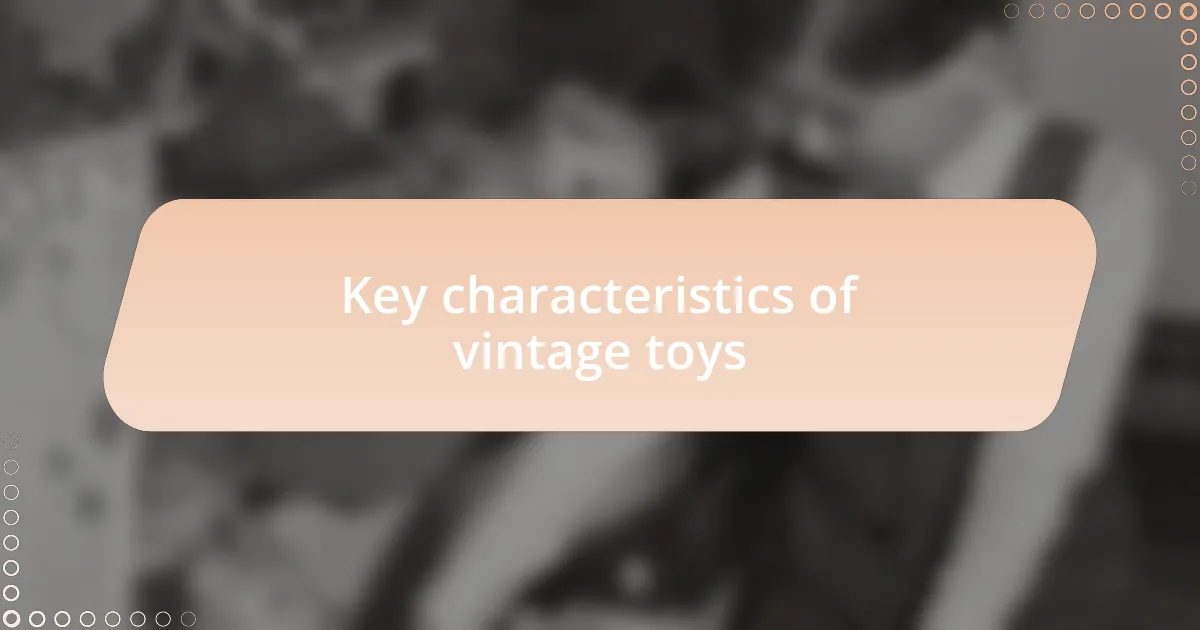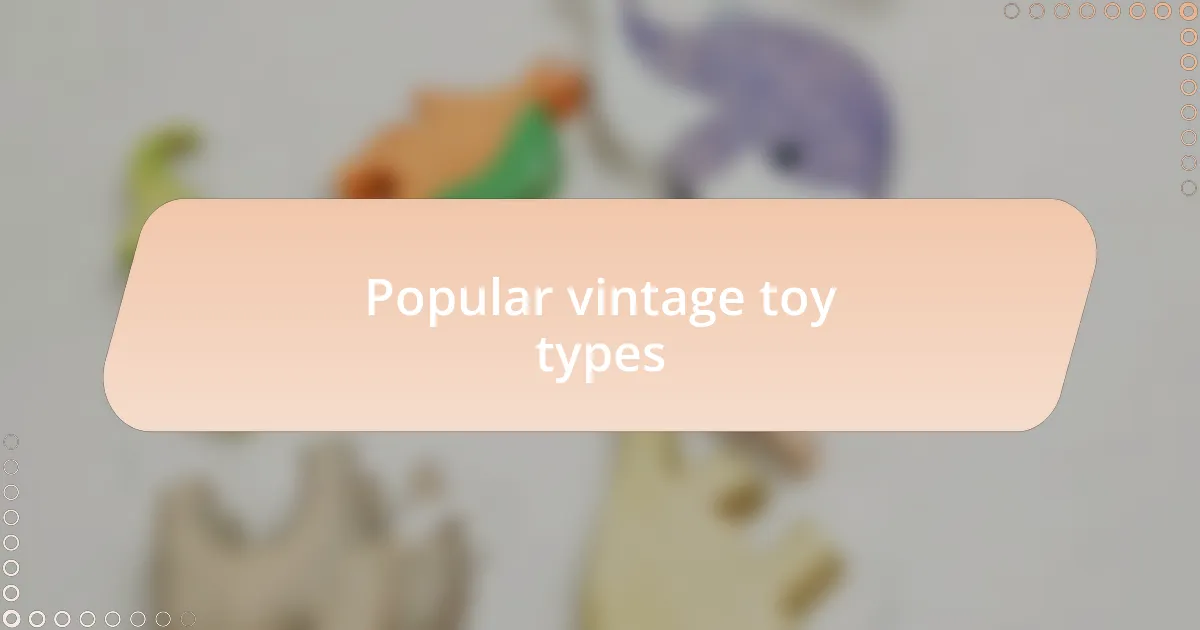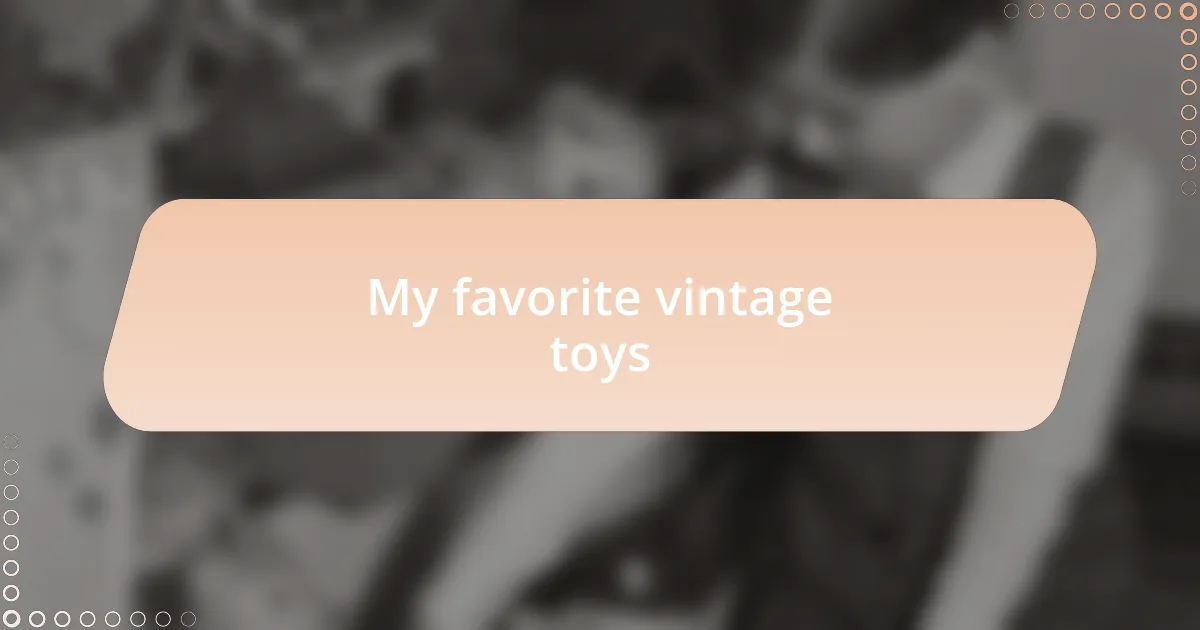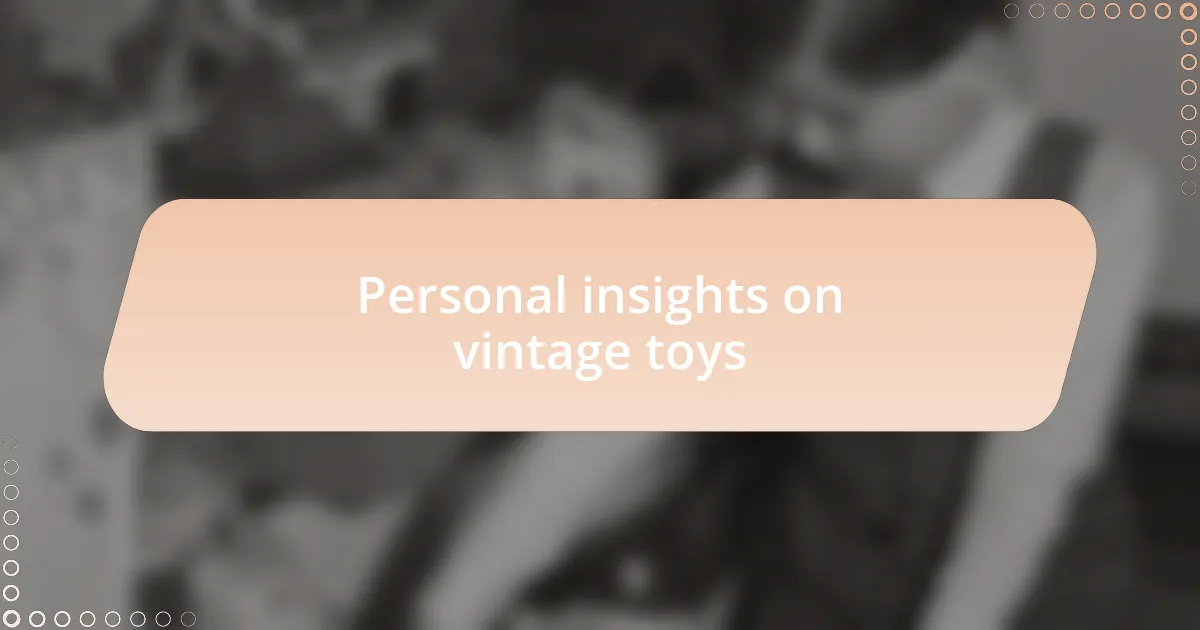Key takeaways:
- Vintage toys evoke nostalgia and connect us to past generations, showcasing cultural significance and craftsmanship.
- The history of toys reflects societal changes, from simple materials in ancient times to the mass manufacturing of the 19th century.
- Key characteristics of vintage toys include their craftsmanship, simplicity, and nostalgic charm, fostering creativity and personal interaction.
- Personal experiences highlight how vintage toys, such as marbles and board games, create lasting memories and connections compared to modern digital alternatives.

Understanding vintage toys
Vintage toys are more than mere playthings; they are cherished relics that evoke nostalgia and memories from our childhoods. I remember the thrill of unearthing a dusty old toy in my grandmother’s attic, feeling as if I had discovered a hidden treasure. It made me reflect on how these objects carry stories not just from their past, but also from the lives of those who played with them.
When we think about vintage toys, we often overlook the cultural significance they hold. Each toy is a snapshot of the era it comes from, representing trends, values, and innovations of its time. Have you ever paused to consider how a simple wooden block can connect us to an entire generation? For me, these toys resonate with the laughter of friends and the joy of imaginative play, building a bridge between past and present.
Moreover, vintage toys often showcase craftsmanship that is increasingly rare today. I recall the satisfaction of holding a metal toy car with intricate details that were thoughtfully designed, unlike many mass-produced toys we see now. Doesn’t it make you wonder what stories those toys could tell if they could speak, or how they might inspire a new generation to embrace creativity and play? Understanding these nuances allows us to truly appreciate the legacy of vintage toys.

The history of playthings
The journey of playthings stretches far back into human history. Think of the earliest toys made from simple materials such as wood, clay, or even stones. I often marvel at how ancient children played with whatever was available, just as my siblings and I would transform everyday objects into imaginative toys. Doesn’t it make you wonder how a humble rock became a cherished companion for countless little ones?
As civilizations evolved, so did the complexity of their toys. In ancient Egypt, for instance, children played with miniature models of animals and dolls made from papyrus. It strikes me that these toys were not just for entertainment; they often had cultural or religious significance. I remember discovering a small painted wooden figure in a flea market, which sparked my curiosity about its past—who played with it, and what stories did it hold?
In the 19th century, industrialization marked a pivotal shift in toy production. Mass manufacturing made toys more accessible, leading to the birth of iconic items like the yo-yo and the tin wind-up toys. I find this era fascinating; it was a time when play became intertwined with marketing and consumer culture. Have you ever stopped to think how this shift towards commercialism affected what children value in play today? For me, it highlights a crucial question about the essence of play and what truly enriches a child’s development.

Key characteristics of vintage toys
One key characteristic of vintage toys is their craftsmanship. Unlike many modern toys, which are produced in vast quantities using plastic and synthetic materials, vintage toys often showcase intricate designs and attention to detail. I recall unearthing a wooden toy train at an estate sale—it was beautifully painted and had well-carved features that offered a tactile experience. Can you feel the difference in quality when handling such a piece? It’s as if each toy carries the spirit of the craftsman who created it.
Another defining aspect of vintage toys is their simplicity. Many of these toys encourage imaginative play without the bells and whistles we see in today’s technology-driven options. When I think back to my own childhood, the joy of building forts with basic blocks seemed so profound. Isn’t it interesting how the absence of features like screens or electronic sounds can actually foster more creativity in children? This simplicity often allows for a more personal interaction with the toy, encouraging kids to invent their own stories and adventures.
Finally, a nostalgic charm permeates vintage toys, evoking memories not just for those who owned them but for anyone who encounters them. I remember visiting a friend’s house and immediately spotting a vintage doll I had as a child, its fabric worn yet somehow vibrant with memories. How does it feel to hold something that resonates with your own past? The emotional connections that vintage toys forge with both individuals and generations create a timeless bond that is harder to find in today’s mass-produced playthings.

Popular vintage toy types
One popular type of vintage toy is the classic model train set. I distinctly remember my uncle setting up a sprawling layout in his basement, complete with little towns and winding tracks. There was something magical about watching the train glide along, its whistle echoing through the space. Do you think modern children experience that same thrill with digital simulations? I often wonder if tangible experiences like this, grounded in reality, can be replaced by pixels on a screen.
Another cherished vintage toy category is dolls, often made from materials like porcelain or cloth. I still have my grandmother’s old rag doll, its patched-up stitching a testament to countless play sessions. When I hold it, I am transported back to long afternoons spent crafting stories and adventures in my imagination. Isn’t it fascinating how a simple doll can ignite such creativity? The tactile feeling of fabric and the softness of the doll’s features remain a stark contrast to many of today’s dolls, which are more focused on appearances than on fostering imaginative play.
Then, there are the vintage action figures that sparked countless battles in living rooms. I remember my brother and I using our imaginations to create elaborate storylines, complete with secret missions and epic showdowns. The thrill of having a tiny figure in your hand, representing a heroic character, was unlike anything else. Can today’s action figures, which often come with predefined storylines, replicate that sense of freedom and possibility? Reflecting on these play experiences, I realize how much vintage action figures encouraged storytelling and camaraderie among children.

My favorite vintage toys
The thrill of playing with marbles was something I cherished during my childhood. I can recall sunny afternoons spent in my backyard, strategically aiming for that perfect shot to knock my opponent’s marbles out of the circle. The clink of glass against glass felt so satisfying, and the joy of winning was just a bonus. Do those colorful little spheres still hold the same excitement for kids today, or has the allure of technology overshadowed such simple pleasures?
One of my fondest memories revolves around vintage toy cars. I loved racing them down our driveway, watching them zoom and collide with dramatic flair. I had a collection of metal die-cast cars that felt solid in my hands, each representing a different adventure. It makes me wonder if children today find the same joy in a physical object, or if their play is predominantly digital. There’s something unique about the tactile nature of these toys that fosters creativity.
Growing up, board games filled our family nights with laughter and friendly competition. I remember the thrill of rolling the dice and navigating my piece around the board, hoping for that winning move. The anticipation of someone landing on my property in Monopoly or the shared tension during a game of Risk created bonds that still bring a smile to my face. Do you think contemporary games invite that same sense of togetherness, or has instant gratification taken the place of patience and strategy in play?

Personal insights on vintage toys
I still remember the soft, fuzzy texture of a classic teddy bear that I held onto tightly during my childhood. It wasn’t just a plush toy; it was my confidant. I would share my secrets and dreams with it, believing it understood me. In a world so rapidly changing, can today’s children experience that same warmth and comfort with a toy that lacks the same tactile connection?
One of the most delightful aspects of vintage toys is the stories they carry. I often think about the delight of discovering a well-loved doll from a garage sale, complete with scuffs and worn-out clothes. It had seen adventures I could only imagine. Holding it in my hands was like connecting with the past, a tangible piece of history that makes me ponder: do modern toys lack that unique character, or is their design prioritizing perfection over personality now?
Growing up with Lego bricks taught me the value of creativity. I spent countless hours building unique structures, and each creation was a reflection of my imagination. The satisfaction of watching something take shape with my own hands was incredible. I can’t help but ask: with the increasing prevalence of pre-made toys today, are children missing out on that profound sense of achievement that comes from creating something entirely their own?